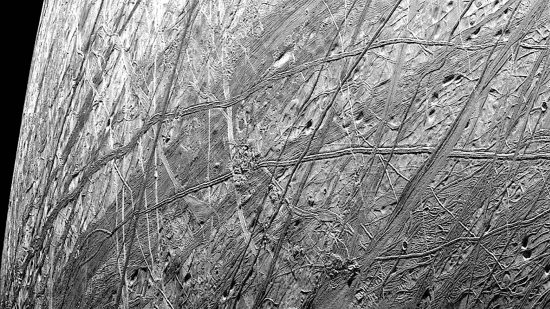
June 2, 2020
A new mission to Europa.
The Galileo spacecraft entered orbit around Jupiter in December 1995. When it ran out of maneuvering fuel, the 320 kilogram probe was incinerated by the Jovian atmosphere, so that it would not crash into one of Jupiter’s moons, particularly Europa.
Planetary scientists were surprised by their first sight of Europa in March 1979: the moon seemed to be completely encased in water ice. That there were few craters was also surprising. Instead, Europa is dominated by sinuous rilles that extend for thousands of kilometers. Cycloid formations, called “flexi”, also mystify NASA scientists. What created such odd structures? As of this writing, that question has yet to be answered.
Sometime in the year 2023, NASA will send the Europa Clipper into orbit around the enigmatic moon. Said Curt Niebur, Europa Program Scientist:
“This is a giant step in our search for oases that could support life in our own celestial backyard. We’re confident that this versatile set of science instruments would produce exciting discoveries on a much-anticipated mission.”
It is thought that there are lakes of water beneath Europa’s crust, just above a salty ocean. A “decoupled” surface is supposed to experience periodic deformation, because movement of the ice creates stress cracks, allowing gigantic rafts to form. They are said to float around Europa, crashing into each other as heat from the interior disturbs their motion. What gives the initial push to those movements? A best guess from conventional sciences is that Europa’s hot core is due to gravity. Jupiter is said to be “kneading” the moon, creating so much friction that the subsurface ice melts.
“Cracking” on Europa continues to be the official interpretation, although high resolution images contradict that assumption. The larger channels are smooth, with a constant channel width, sometimes for over a thousand kilometers. In an Electric Universe, such features are not surprising. An electric arc, flowing across the surface, can be “pinched” by its magnetic field into a thin filament that draws other filaments into parallel alignment.
The Europa Clipper mission will see whether Europa might have conditions suitable for life. It will conduct repeated close flybys from an orbit around Jupiter. Cameras and spectrometers will provide high-resolution images, while ice penetrating radar will analyze the moon’s icy shell, searching for subsurface lakes similar to those beneath Antarctica. A magnetometer will measure the strength and direction of the moon’s magnetic field, hopefully giving planetary scientists insight into the depth and salinity of the moon’s putative ocean.
Europa’s rilles have no analog to ice cracks on Earth. Ice breaks chaotically, so variations in thickness and composition that repeat over long distances should not be expected. Yet, repetitive patterns are observed on Europa. The swirls and loops that cover the moon are duplicated in the laboratory using plasma discharge equipment.
Computer simulations that rely on tides, interior heating, or other routine, Earth-like phenomena are not taking into account the most powerful force in nature: electricity. Europa’s liquid ocean is most likely a data modeling illusion.
Stephen Smith
The Thunderbolts Picture of the Day is generously supported by the Mainwaring Archive Foundation.












